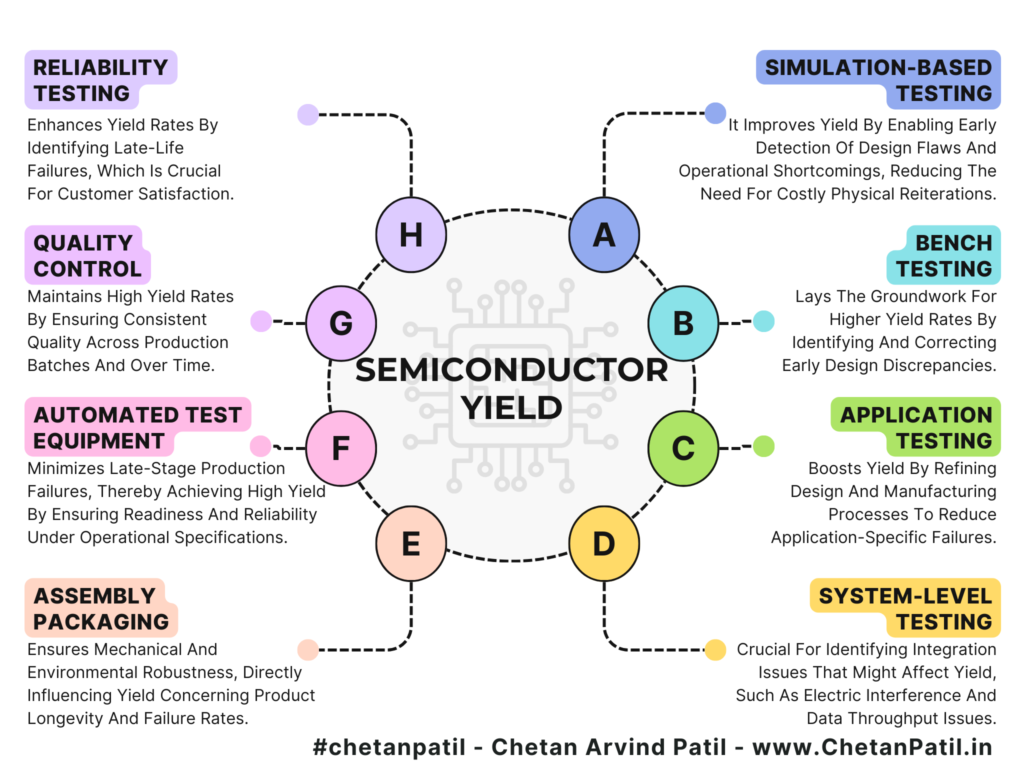Image Generated Using DALL-E
Semiconductor Product Development And Yield Correlation
The semiconductor industry continually innovates and introduces new products to meet the growing demands for more powerful and efficient electronic devices. The successful launch of these new semiconductor products always hinges critically on yield.
As such, yields are not just a statistic in semiconductor terminology. They impact the production costs per usable chip, which can significantly affect profit margins, particularly in a highly competitive market with limited pricing power.
From A Semiconductor Product Perspective: Yield is considered after the chip has been fabricated, assembled, and tested. It involves the proportion of chips that function correctly and meet the desired performance specifications. This aspect of yield is crucial because it determines the compliance, quality, and eventually the profitability of the new semiconductor product.
Moreover, the correlation between yield and the broader semiconductor industry extends to how companies manage their supply chains and respond to market demands. Thus, a stable and high yield is crucial for maintaining reliable product supply, affecting market share and consumer confidence.
Eventually, effective yield management will support cost efficiency, product quality, strategic positioning, and competitive advantage in the semiconductor landscape.
Setting And Achieving The Target Yield
Setting the target yield in semiconductor product development is a critical strategic decision that balances technical feasibility with business goals. Companies often set this target based on historical yield data, technology (node) used, product complexity, and defectivity to anticipate and mitigate potential production to cost challenges.
“What Is Target Yield? Refers to the predefined goal for the percentage of functional units produced from a batch of semiconductor wafers. Semiconductor companies set a target yield to measure the efficiency and effectiveness of their products and processes. Setting a target yield is vital for several reasons, including cost control, production planning, and ensuring the economic viability of manufacturing operations.”
On other hand, achieving yield targets is a multifaceted process that involves a series of detailed and strategic testing stages. Each stage addresses different aspects of a semiconductor’s functionality and performance, progressively ensuring that yield targets are verified and, if not met, then the product is improved through another silicon revision by root causing the issue.
Below are the different testing methods that are used to validate the semiconductor product and the yield:
| Stage | Description | Impact on Yield |
|---|---|---|
| Simulation-Based Testing | Utilizes advanced computational models to predict how a semiconductor device will behave under various physical, electrical, and environmental conditions before actual physical testing begins. It helps identify potential issues before they manifest in real-world scenarios. | It improves yield by enabling early detection of design flaws and operational shortcomings, reducing the need for costly physical reiterations. |
| Bench Testing | Initial assessment of each chip under controlled conditions to verify it meets fundamental design specifications. | Lays the groundwork for higher yield rates by identifying and correcting early design discrepancies. |
| Application Testing | Tests the chip within its specific intended application (e.g. a computer processor) to evaluate performance in operational environments. | Boosts yield by refining design and manufacturing processes to reduce application-specific failures. |
| System-Level Testing | Integrates the chip with other hardware and software to ensure compatibility and meeting performance metrics across a system. | It is identifying integration issues that might affect yield, such as electric interference and data throughput issues. |
| Assembly/Packaging | It involves encapsulating the die in a protective casing and testing for physical, thermal, and chemical resilience. | Ensures mechanical and environmental robustness, directly influencing yield concerning product longevity and failure rates. |
| Test/Automatic Test Equipment (ATE) | Simulates real-world operating conditions to test the chips for quality and durability rigorously. | Minimizes late-stage production failures, achieving high yield by ensuring readiness and reliability under operational specifications. |
| Quality Control | Testing all manufacturing process aspects to adhere to stringent quality standards. | Maintains high yield rates by ensuring consistent quality across production batches and over time. |
| Reliability Testing | Focuses on the long-term performance of the chips, predicting and improving life expectancy and failure rates. | Enhances yield rates by identifying late-life failures, which is crucial for customer satisfaction. |

Yield And COGS
In the semiconductor industry, the Cost of Goods Sold (COGS) encompasses various elements such as fabrication, assembly, testing, material costs, direct labor costs, and other overheads. However, the one factor that truly holds the power to influence the product margin, driven by COGS, is yield. Thus, reduction or increasing in the number of good products per wafer (i.e. yield) impacts manufacturing costs (COGS), making it a crucial aspect to consider.
Below is a view of how achieving a target yield helps with lower COGS and the production of a product:
Impact On COGS: Improved yields directly lead to lower COGS as the effective utilization of inputs (materials, labor, and capital) increases. It is crucial in the semiconductor industry, where price erosion is common, and the ability to rapidly reduce costs can be a significant competitive advantage.
Pricing Flexibility: Lower COGS allows greater flexibility in pricing its products. It can be critical in competitive markets or when companies seek to penetrate new markets by underpricing competitors without sacrificing margins.
Profitability: Lower COGS resulting from higher yields boosts gross margins, a key indicator of production efficiency and profitability. In a capital-intensive industry like semiconductors, where initial investments and fixed costs are high, maximizing yield is often synonymous with maximizing profitability.
Inventory Management: Higher yields can lead to more consistent production outputs, which helps better inventory management. Companies can reduce the buffer stocks they might otherwise hold to compensate for potential yield variability, thus minimizing the costs associated with holding inventory.
Eventually, companies that excel in yield optimization improve their operational efficiencies and strengthen their financial (where COGS is crucial) position, providing more stability in the volatile semiconductor market.
Semiconductor Yield Take Away
By now, it is obvious how important the yield is in validating new semiconductor products. Yield also influences several aspects of a semiconductor company’s operations, from financial stability to market competitiveness.
To summarize, here are four key takeaways on how crucial yield is during the validation phase of new semiconductor products:
- Cost Efficiency And Profitability:
- Yield directly impacts the cost efficiency of semiconductor manufacturing. Higher yields mean more functional devices are produced per batch, reducing the per-unit cost of production. This cost-saving is crucial when scaling up production for market launch.
- Effective yield management during the validation phase can dramatically enhance profitability by minimizing waste and optimizing resource use, setting a solid foundation for competitive pricing and healthy profit margins as the product enters the market.
- Product Quality Add Reputation:
- Achieving a high yield is synonymous with ensuring product quality during validation. High yield indicates that the manufacturing processes can consistently produce devices that meet or exceed specifications.
- This strengthens customer trust and satisfaction and enhances the product’s reputation for reliability. A high yield during product validation can thus serve as a quality assurance marker, reassuring stakeholders and customers about the product’s performance and durability.
- Time To Market And Competitive Advantage:
- Yield optimization during validation affects a company’s agility and speed in bringing new products to market. High yield rates allow for a smoother transition from development to full-scale production, reducing delays caused by extensive troubleshooting and reiterations.
- This speed to market is a crucial competitive advantage, especially in a fast-paced industry like semiconductors, where being first can dictate market leadership and capture significant market share.
- Supply Chain Stability And Responsiveness:
- High yields during the validation phase contribute to supply chain stability by ensuring production volumes meet forecasted demands. This stability is crucial for maintaining consistent customer supply and responding flexibly to market demand changes.
- Moreover, predictable and stable yields reduce the risk of stockouts and excess inventory, thus optimizing the supply chain operations and reducing logistical costs.
In conclusion, yield must be considered critical when designing, manufacturing, and validating new semiconductor products. More so, when yield touches every essential aspect of a semiconductor company’s operations – from cost structure and product quality to market positioning and supply chain management.
In the long term, effective yield management during product validation is a strategic imperative that underpins operational efficiency and the long-term success of a product in the semiconductor industry.






